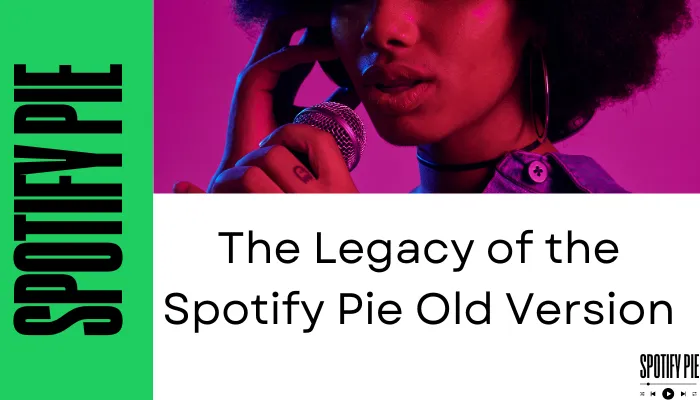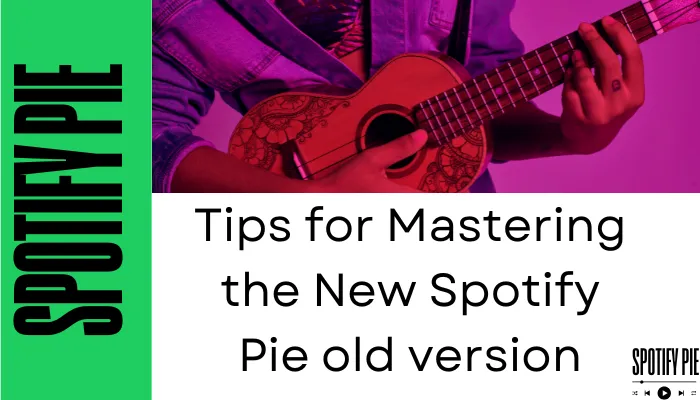The Spotify Pie old version wasn’t just a data visualization tool; it was a conversation starter, social media badge, or your unique listening habits photography.
NLP technology has transformed many aspects of our lives, including data visualization and content analysis. In this article, we take a trip down memory lane to explore the old version of Spotify, focusing on its unique feature known as Spotify Pie old version.

The user interface of the old version was simple yet intuitive. Users could access their pie chart within the Spotify app or on the web platform. The pie itself was visually appealing, with vibrant colors representing different genres.
Though the exact functionalities of the old version might be somewhat blurry in our minds today, for many Spotify veterans they remain unforgettable moments of discovery about one’s music preferences through a beautiful visual format.
Why Did the Spotify Pie Old Version Disappear?
Eventually, as Spotify developed further, it got rid of its old version that included Spotify Pie old version.
There has been no official confirmation surrounding why it happened but some suspect the company decided to shift its focus towards new features and data privacy issues may have played a part in it.
The Legacy of the Spotify Pie Old Version
Spotify Pie old version, is not just a data visualization tool – its impact exceeds that. It served as a hub for Spotify users to connect with each other, led to discussions on music discovery, and was just a fun way to share favorite songs.

However, there are still third-party services that provide the same functionality as the Spotify Pie old version. They enable you to generate a pie chart based on your current listening habits and thus continue preserving the mood of the previous version for a new generation of music lovers.
Therefore, next time you open up Spotify and start getting carried away by your most-loved playlist remember the Spotify Pie old version. Though it has become history, it still reminds us how far Spotify has come and how powerful music can be in bringing people together.
What Was The Spotify Pie Old Version And Why Did People Love It?
The Spotify Pie old version was certainly not a part of the native features of the Spotify app itself. Instead, it was a third-party tool that accessed your listening data and turned it into a visually appealing pie chart.
- Visually Appealing: This format employed for the pie chart made your listening trends more apparent at once.
- Social Sharing: These pie charts could easily be shared on various social media platforms sparking conversations and friendly competition among music enthusiasts.
- Genre Exploration: It gave insights about top genres that led to potential revelations regarding concealed preferences or lost favorites.
- A Snapshot in Time: Unlike Spotify Wrapped which is an annual summary, one can create a pie chart at any point thus providing a dynamic analysis of changing musical tastes over time.
Each slice of pie represented a different genre you listened to; the size reflected how much time you spent on each genre as a percentage of your overall listening time. The appeal of this services could be summed up as follows:
Exploring Functionality and Limitations of Spotify Pie Old Version
As much as many music lovers loved The Spotify Pie old version, there were various limitations associated with it. These include:
- Functionality: The pie chart focused on genres to give a snapshot of your listening patterns. Although it showed top genres, the information about particular artists within these genres was rarely available. However, this had its own set of problems such as possible security risks and reliance on the continued development of the tool.
- Limitations: Some users had questions about giving their listening data to a third-party tool. There were no options for specifying time frames or excluding certain types of music in relation to the pie chart. Without continuous existence and maintenance by a third-party tool, there is no functionality for the pie chart itself.
What Do Users Think?
A feature’s success can only be measured in terms of user sentiment with regards to it. Here are some insights into what people think about Spotify Pie old version:
| Platform | Description |
|---|---|
| Forum Discussions | These online forums exploded with users showing off unique musical landscapes and comparing them through discussions on pie charts. |
| Social Media Reactions | This social media sensation displayed a number of individuals’ favorite music types and some hidden gems that they cherished. |
| Surveys and Polls | While no large-scale surveys were conducted specifically on the pie chart, user feedback on social media and forums indicated a generally positive reception. |
The Future Of Music Sharing Beyond The Spotify Pie old version
However, the Spotify Pie old version is not available now but it is still recognized as a key factor in the history of music sharing. This saw users needing to visually depict their musical timelines and share them with others. Here’s what we might expect in the future.
- Native Integration: Privacy concerns may be addressed by Spotify itself by incorporating a pie chart or other visualization instrument on the application which will enable more data control.
- Advanced Customization: The upcoming generations could probably have a feature that allows users to customize the chart with the time frame, genre filters, or an option for choosing artists among others.
- Interactive Features: Ponder about this: just imagine having a pie chart whereby after clicking on any piece, you are shown your favorite artist within that genre or even one can create a playlist using it.
However, it’s possible to consider Spotify Pie old version as a mere chapter since it was a milestone in the evolution of music sharing. It proved how powerful visual representation and user-driven exploration can be when applied in this field of technology too.
As streaming services continue to innovate, music lovers can look forward to much more exciting ways of expressing themselves through music and finding common ground with each other over songs they love.
Why the Update?
Spotify’s choice to update Spotify Pie old version was not taken lightly. Here are some possible reasons behind that shift:
Enhanced Functionality: While artistically beautiful, but had no other functions. There may be features such as time filtering and direct sharing within the app through improved genre breakdowns on the new version.
Improved Data Accuracy: It is possible that initial iterations came with limitations for data collection. Possibly, it could provide more accurate and personalized information about individual habits of listening.
Integration with Spotify Ecosystem: This new Spotify pie old version can be woven together with other features of Spotify leading to a more consistent user experience.
Challenges Users Faced During the Transition
Even positive change can cause resistance. Here are some challenges users might have encountered during the transition:
- Learning Curve: People need time to adapt to changes in interface & functionality. Users might find it hard to navigate through the new Spotify pie old version application compared to the old one where they were connected earlier
- Loss of Familiarity: The original pie chart had its own appeal. Some people will feel like losing simplicity and comprehensibility in structure patterns by losing access to the previous representation format.
- Missing Features: Probably there are some well-liked tools from the previous versions that haven’t been included in the newer ones, and this can be irritating for users.
Tips for Mastering the New Spotify Pie old version
The original Spotify pie old version is cherished by many but it is important to embrace the new possibilities. Here are a few tips on how you can maximize your use of the updated version:

Dive into Tutorials: Spotify likely offers resources to help users understand the new features. Be sure to go through tutorials, FAQs, or even YouTube videos to navigate through the new interface convincingly.
Explore Customization Options: The new Spotify Pie version might allow for customization. Personalize it by tinkering with settings so that they are meaningful and express something about yourself within this data visualization tool.
Focus on the Benefits: The update might offer functionalities that weren’t available in the old version. Concentrate on what makes a better Spotify Pie old version like insights into your listening habits or easier sharing capabilities.
The Legacy of the Spotify Pie Old Version
The impact of the Spotify pie old version goes beyond just data visualization. It was built as a way for music lovers to connect with each other; leading conversations and social interactions among them. Below is an account of its lasting effects:
- A Pop Culture Phenomenon: The Spotify pie old version became all popular over social media. Furthermore, showing off their individual charts became an opportunity for people to come closer together, demonstrate personal musical taste, and find out about musicians they had never heard before.
- Promoting Music Discovery: This was done using pie charts where the users were at liberty to sink deep into diverse genres and artists indicated by the segments. In that regard, there could have been some songs or bands they didn’t know about before.
- A Celebration of Individuality: Spotify Pie old version gave an exceptional opportunity for everyone to show off their musical taste in a unique way. It was a visual representation of why every person’s taste is special.
Conclusion
The transition from Spotify Pie old version to new versions is also a testament to the ever-changing nature of technology. In addition, though change can be tough, it may result in betterment and novel features in the process.
The Spotify Pie old version is no more but its legacy as a place for music discovery and community lives on. Let it also be an opportunity to embrace what lies ahead with open arms while at the same time affectionately remembering those moments that made the first iteration of Spotify such a precious experience.
